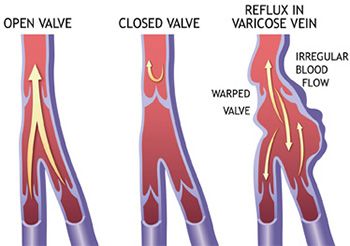*Open 7 days a week
*Late evening appointments
*Open 7 days a week
*Late evening appointments
When Your blood doesn’t flow properly through your veins and arteries, symptoms can flare up suddenly and drastically. You may think, for example, that your legs are just tired after working all day when in actuality, you may have venous insufficiency that’s impeding proper blood flow. This is a condition that doesn’t go away on its own. You need treatment from a top Brooklyn vein specialist at Century Medical and Dental Center. And the earlier you receive treatment, the better odds you have of reducing the risks of severe consequences. So call today for an appointment.

When the veins in your legs are healthy, they transport blood back to your heart properly. The one-way valves in your legs keep blood from flowing backwards. When these valves don’t work correctly, blood collects in the veins of your lower legs, which is called stasis. A condition in which leg veins have difficulty sending blood back to your heart is known as venous insufficiency.
When blood pools in your lower leg, fluid leaks out of the veins and causes the skin to become itchy and inflamed. This is called stasis dermatitis. The Brooklyn vein doctors at Century Medical and Dental Center provide you with chronic venous insufficiency treatment and venous stasis dermatitis treatment. And since these vein specialists are part of a multi-disciplinary practice, you can receive treatment for any co-occurring or underlying medical conditions that led to your vein issues.
Swelling in your ankles and lower legs, especially if you tend to stand for long periods of time, may be a sign of chronic venous insufficiency. Other symptoms include:
Skin changes that may indicate chronic venous stasis dermatitis include:
If your condition isn’t treated, symptoms usually worsen. Tissue damage can lead to venous stasis ulcers or sores on your skin’s surface. Venous stasis ulcers can become infected, and they’re sometimes very difficult to treat. Gangrene or cellulitis can set in, possibly leading to amputation of your foot or leg.
Venous insufficiency is caused by damage to the valves that keep the blood flowing in one direction, up toward the heart. The most common causes of valve damage include:
You’re at increased risk of developing this condition if others in your family have had it. Obesity, pregnancy and a history of deep vein thrombosis are other risk factors. If you develop deep vein thrombosis as a result of a blood clot in your leg, chronic venous insufficiency (CVI) may develop. Pelvic tumors and vascular malformations also can cause CVI. The vein disorder affects women more than men and typically strikes after the age of 50.
Your Brooklyn doctor examines your legs. Questions follow about your medical history. Make sure you describe the symptoms you’re experiencing.
A vascular or duplex ultrasound is used to examine the circulation in your legs. This test measures the speed and direction of blood flow in your legs. It’s a non-invasive test that’s performed by passing a small device called a transducer over your skin.
“Friendly doctors and staff! Office was clean and comfortable. Doctor was caring and knowledgeable, taking time to really listen to me and answer all my questions.” - Katie Thigpen
200 Livingston Str,
Brooklyn, NY 11201
908 reviews
770 Flatbush Ave
Brooklyn, NY 11226
234 reviews
827 11th Ave
Manhattan, NY 10019
88 reviews
260 Ave X
Brooklyn, NY 11223
261 reviews
180 Myrtle Ave
Brooklyn, NY 11201
90 reviews
In its early stages, treatment for venous insufficiency involves making lifestyle changes, such as:
As venous insufficiency progresses and you’re experiencing increasing leg pain or sores on your skin, your doctor may suggest other forms of venous stasis treatment. Antibiotics may be prescribed for skin ulcer treatment and treatment of skin infections. Other treatment methods may include:
Your doctor may prescribe medication to help increase blood flow through the blood vessels and to prevent blood clots. Topical corticosteroids may be used as a form of venous stasis dermatitis treatment. Fewer than 10 percent of the people who develop CVI require surgery, but when it’s necessary, it may include:
Do not ignore the symptoms of venous insufficiency. Treatment started in the early stages allows you to manage your condition or prevent it from getting worse. This condition doesn’t go away by itself.
If you’re experiencing pain or swelling in your lower legs and ankles, contact the Downtown Brooklyn medical practitioners at Century Medical and Dental Center. You’ll receive a firm diagnosis so that you can begin the best treatment options for your specific condition.

Century Medical and Dental Center is an accredited healthcare facility in NY that operates in accordance with Article 28, a public health law. This law regulates and recognizes accreditation for public healthcare facilities, ensuring they are licensed and operated correctly. By undergoing the Article 28 process and achieving accreditation, Century Medical and Dental Center demonstrates its commitment to meeting the highest standards of care.
As a multidisciplinary medical center, we have highly qualified doctors, nurses, and support staff who are working hard to provide the best medical care to patients in Midtown Manhattan, NY, Downtown Brooklyn, NY, including Brooklyn Heights, Dumbo, Prospect Heights, Park Slope, Clinton Hill, Boerum Hill, Red Hook, and Bedford-Stuyvesant.